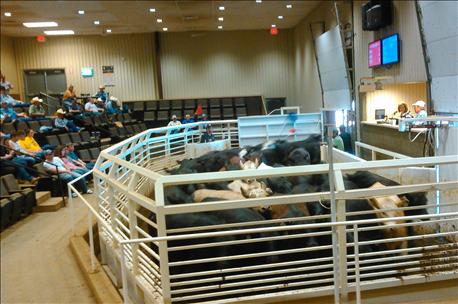
If you buy or sell livestock at a local sale barn in Indiana, you’re likely used to an older facility, perhaps with wooden bleachers and a dirt-floor ring covered with sawdust. There is nothing wrong with those facilities. They still serve a purpose as a selling place for someone who has a limited number of animals to sell. Sometimes it’s an opportunity for someone who wants a few animals to put on summer pasture to pick up what they need at a reasonable price.

AUCTION TIME: This auction ring is more than a ring; it’s also a scale.
Walking into some of Indiana’s country sale barns is like stepping back in time. At one such facility, even today, the auctioneer pulls one light string to switch on a bulb if selling by the head, another one if selling by the pound. Little has changed on the inside in decades. Some regulars joke that even the cobwebs have been there for generations.
Recently, I visited a cattle auction at the OKC West stockyards outside of Oklahoma City. Thursday is auction day, and hundreds of head of cattle go through the ring, sold to the highest bidder. Some are feeders coming off winter pasture, which might be wheat doubling as pasture and a cash crop.
The facility is fairly new, rebuilt after a tornado in 2012. As you leave the office and enter the sale ring, you can’t help but notice the walk-in shelter on your left. The sign says, "Tornado shelter, occupancy 34." You won’t find that at any sale barn in Indiana!
The auctioneer is up on a podium just like at an Indiana sale barn. But there are no lightbulbs with pull chains. Instead, there are electronic computer displays, which flash facts such as number of animals in the lot, average weight of the animals and total weight of the lot.
Some lots include as many as 30 head. That’s a lot of heifers or steers to run through a scale one at a time. Don’t worry. It may work that way at small sale barns, but not at this one. The sale ring is actually a scale, suspended from the rest of the floor so it can accurately sense the weight. The weight automatically displays on the electronic screens.
At Indiana auctions, most people raise their hand to bid these days, although some salty, seasoned livestock buyers have other ways to signal a bid. When cattle buyers or ranchers want to bid in Oklahoma, often they use something besides their hands to signal the ringman or auctioneer. Maybe it’s a tip of the cowboy hat, quite common in the crowd, or maybe it’s a nod of the head.
Even to a veteran auction-goer like me, it wasn’t always obvious who was bidding. But the auctioneer knew exactly what was going on. I imagine the veteran buyers and sellers did, as well.
I wonder if they would feel at home in an Indiana sale barn? After a few minutes, I felt at home in the Oklahoma sale barn. Some things are universal, like an appreciation for how cattle are bought and sold. Commerce is commerce, whether in a high-tech sale barn or one with cobwebs and lightbulbs with pull chains.
About the Author(s)
You May Also Like




